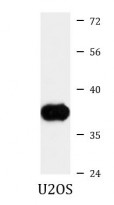ARG56886
anti-Wnt3a antibody
anti-Wnt3a antibody for Western blot and Human,Mouse
Overview
| Product Description | Rabbit Polyclonal antibody recognizes Wnt3a |
|---|---|
| Tested Reactivity | Hu, Ms |
| Tested Application | WB |
| Host | Rabbit |
| Clonality | Polyclonal |
| Isotype | IgG |
| Target Name | Wnt3a |
| Antigen Species | Human |
| Immunogen | Recombinant fusion protein corresponding to aa. 1-352 of Human Wnt3a (NP_149122.1). |
| Conjugation | Un-conjugated |
| Alternate Names | Protein Wnt-3a |
Application Instructions
| Application Suggestion |
|
||||
|---|---|---|---|---|---|
| Application Note | * The dilutions indicate recommended starting dilutions and the optimal dilutions or concentrations should be determined by the scientist. | ||||
| Positive Control | U2OS | ||||
| Observed Size | ~ 38 kDa |
Properties
| Form | Liquid |
|---|---|
| Purification | Affinity purified. |
| Buffer | PBS (pH 7.3), 0.02% Sodium azide and 50% Glycerol. |
| Preservative | 0.02% Sodium azide |
| Stabilizer | 50% Glycerol |
| Storage Instruction | For continuous use, store undiluted antibody at 2-8°C for up to a week. For long-term storage, aliquot and store at -20°C. Storage in frost free freezers is not recommended. Avoid repeated freeze/thaw cycles. Suggest spin the vial prior to opening. The antibody solution should be gently mixed before use. |
| Note | For laboratory research only, not for drug, diagnostic or other use. |
Bioinformation
| Database Links | |
|---|---|
| Gene Symbol | WNT3A |
| Gene Full Name | wingless-type MMTV integration site family, member 3A |
| Background | The WNT gene family consists of structurally related genes which encode secreted signaling proteins. These proteins have been implicated in oncogenesis and in several developmental processes, including regulation of cell fate and patterning during embryogenesis. This gene is a member of the WNT gene family. It encodes a protein which shows 96% amino acid identity to mouse Wnt3A protein, and 84% to human WNT3 protein, another WNT gene product. This gene is clustered with WNT14 gene, another family member, in chromosome 1q42 region. [provided by RefSeq, Jul 2008] |
| Function | Ligand for members of the frizzled family of seven transmembrane receptors. Wnt-3 and Wnt-3a play distinct roles in cell-cell signaling during morphogenesis of the developing neural tube. [UniProt] |
| Cellular Localization | Secreted, extracellular space, extracellular matrix. Secreted. [UniProt] |
| Calculated MW | 39 kDa |
| PTM | Palmitoleylation by PORCN is required for efficient binding to frizzled receptors. Palmitoleylation is required for proper trafficking to cell surface, vacuolar acidification is critical to release palmitoleylated WNT3A from WLS in secretory vesicles (PubMed:20826466, PubMed:21244856, PubMed:24292069). Depalmitoleylated by NOTUM, leading to inhibit Wnt signaling pathway, possibly by promoting disulfide bond formation and oligomerization (PubMed:25731175). Proteolytic processing by TIKI1 and TIKI2 promotes oxidation and formation of large disulfide-bond oligomers, leading to inactivation of WNT3A. Disulfide bonds have critical and distinct roles in secretion and activity. Loss of each conserved cysteine in WNT3A results in high molecular weight oxidized Wnt oligomers, which are formed through inter-Wnt disulfide bonding. [UniProt] |
Images (1) Click the Picture to Zoom In






